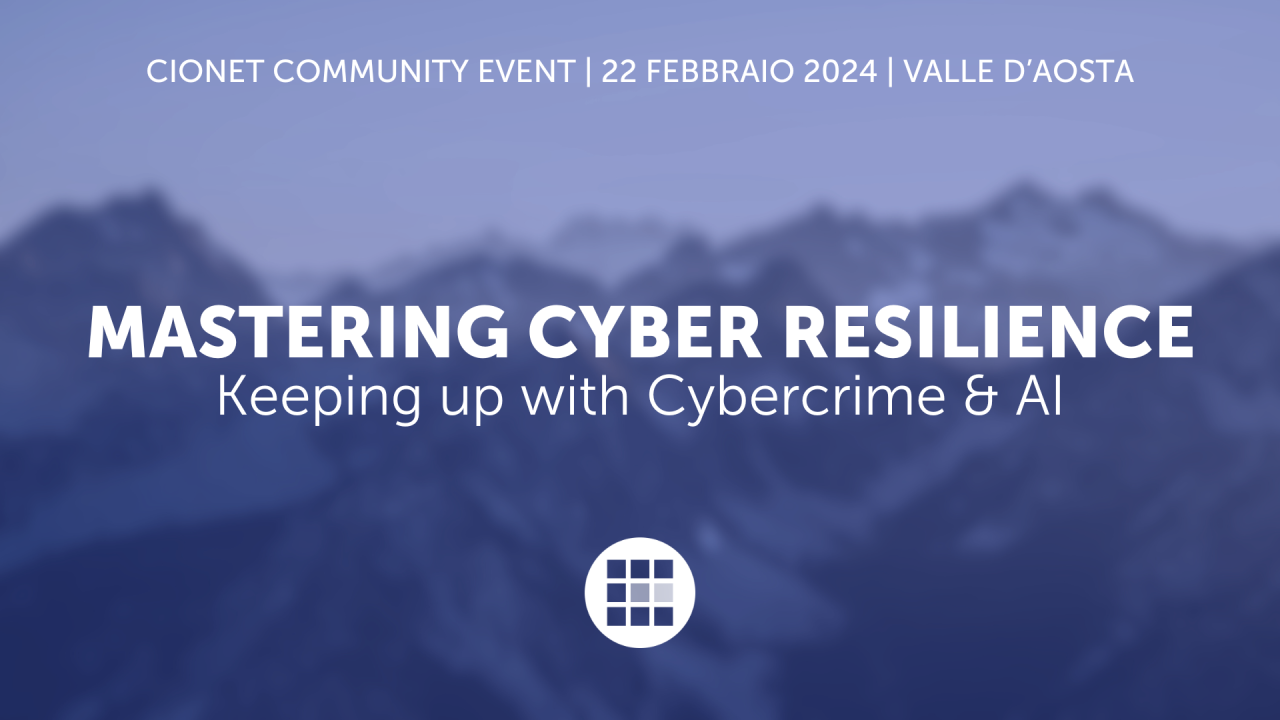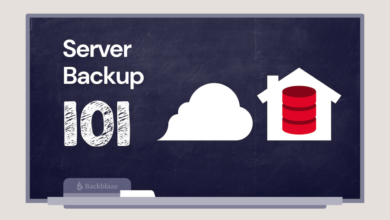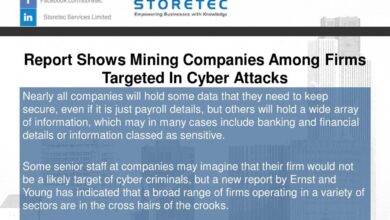
Building Cyber Resilience in a Cloudy World 2
Building Cyber Resilience in a Cloudy World 2 takes us on a journey into the heart of modern cybersecurity. The cloud, while offering incredible scalability and flexibility, introduces a whole new set of challenges to protecting our data and systems. This exploration delves into the unique threats posed by cloud environments, the strategies for mitigating those risks, and the crucial role of a proactive, resilient security culture.
We’ll uncover how to build a robust defense against the ever-evolving landscape of cyber threats in the cloud, from implementing cutting-edge security controls to leveraging the power of automation and AI.
We’ll examine the differences between traditional cybersecurity approaches and the more adaptable, proactive nature of cyber resilience. We’ll dissect real-world examples of cloud breaches, analyze vulnerabilities across different cloud models (IaaS, PaaS, SaaS), and detail how to build an effective incident response plan. This isn’t just about technical solutions; we’ll also discuss the importance of fostering a security-conscious culture within your organization, empowering your team to be your first line of defense.
Defining Cyber Resilience in Cloud Environments
The shift to cloud computing has revolutionized how businesses operate, offering scalability, flexibility, and cost-effectiveness. However, this migration also introduces new and complex cybersecurity challenges. Traditional security approaches, often designed for on-premise infrastructure, struggle to keep pace with the dynamic nature of cloud environments. Understanding and building cyber resilience is no longer a luxury but a necessity for organizations leveraging the cloud.Traditional cybersecurity focuses primarily on prevention – erecting walls to keep threats out.
This involves firewalls, intrusion detection systems, and antivirus software. Cyber resilience, on the other hand, takes a more holistic approach. It acknowledges that breaches are inevitable and focuses on minimizing the impact and recovering quickly from attacks. In the context of cloud computing, this distinction becomes even more critical.
Key Differences Between Traditional Cybersecurity and Cyber Resilience in Cloud Environments
Traditional security methods often struggle to adapt to the shared responsibility model inherent in cloud computing. For instance, a cloud provider is responsible for the security
- of* the cloud (e.g., the underlying infrastructure), while the customer is responsible for security
- in* the cloud (e.g., data security and application security). This shared responsibility necessitates a shift from solely preventative measures to a more proactive and adaptive approach – the essence of cyber resilience. Traditional methods also lack the agility to respond to the rapid changes and scalability of cloud environments. A sudden surge in traffic or a new vulnerability requires quick adaptation, something traditional systems may not handle effectively.
Cyber resilience incorporates automation, orchestration, and continuous monitoring to address these dynamic challenges.
Challenges Posed by Cloud Environments to Traditional Security Approaches
The distributed nature of cloud environments presents significant challenges. Data might reside across multiple regions and availability zones, making traditional perimeter-based security models ineffective. Furthermore, the shared responsibility model requires clear delineation of responsibilities between the cloud provider and the customer, which often proves complex to manage. The rapid pace of innovation in cloud services also makes it difficult for traditional security solutions to keep up.
New services and features constantly emerge, requiring continuous updates and adaptation of security measures. Finally, the complexity of cloud architectures can hinder visibility and monitoring, making it challenging to identify and respond to threats effectively. Legacy security tools often lack the capabilities to effectively analyze and respond to threats within a cloud environment.
Defining Cyber Resilience in Cloud-Based Systems
Cyber resilience in a cloud environment refers to an organization’s ability to anticipate, withstand, recover from, and adapt to cyberattacks and disruptions. It encompasses not only technological solutions but also organizational processes, people, and governance. A resilient cloud system is characterized by its ability to rapidly detect and respond to threats, minimize the impact of successful attacks, and restore operations quickly and efficiently.
This involves implementing robust security controls, establishing effective incident response plans, and fostering a culture of security awareness throughout the organization. It’s about building systems that can bounce back, not just withstand, an attack.
Framework for Assessing Cyber Resilience Posture, Building cyber resilience in a cloudy world 2
A robust framework for assessing cyber resilience in cloud environments should encompass several key areas. First, risk assessment is paramount; identifying and prioritizing potential threats and vulnerabilities specific to the cloud infrastructure and applications. Next, security architecture review is crucial, ensuring that the cloud deployment aligns with best practices and incorporates appropriate security controls. Then, incident response planning must be developed and regularly tested to ensure efficient recovery from cyber incidents.
Furthermore, continuous monitoring and threat detection are essential to proactively identify and address potential threats. Finally, regular security audits and penetration testing should be conducted to validate the effectiveness of security controls and identify weaknesses. This framework allows organizations to gain a comprehensive understanding of their cyber resilience posture and identify areas for improvement. For example, a company might discover vulnerabilities in their cloud storage configuration during a security audit, leading to the implementation of stricter access controls and data encryption policies.
This proactive approach is fundamental to building and maintaining cyber resilience in a dynamic cloud environment.
Cloud Security Threats and Vulnerabilities
The migration to cloud computing offers numerous benefits, but it also introduces a new set of security challenges. Understanding these threats and vulnerabilities is crucial for building robust cyber resilience. This section will explore the top threats, real-world examples, vulnerabilities across different cloud deployment models, and mitigation strategies.
Top Five Critical Cloud Security Threats
The cloud’s shared responsibility model means both cloud providers and users share security duties. However, certain threats consistently pose significant risks. Five of the most critical are: data breaches, misconfigurations, insider threats, denial-of-service (DoS) attacks, and malware infections. These threats can lead to significant financial losses, reputational damage, and legal repercussions.
Examples of Real-World Cloud Security Breaches and Their Root Causes
Numerous high-profile breaches highlight the potential consequences of cloud security failures. For example, the 2017 Equifax breach, resulting from an unpatched Apache Struts vulnerability, exposed sensitive personal information of millions. The root cause was a failure to implement timely patching and vulnerability management practices. Similarly, the 2021 SolarWinds attack exploited a software supply chain vulnerability, compromising numerous organizations that relied on the compromised software.
This underscores the importance of secure software development practices and robust vendor risk management. These incidents demonstrate that even large organizations with sophisticated security measures can be vulnerable to well-executed attacks.
Security Vulnerabilities Across Different Cloud Deployment Models
Different cloud deployment models—Infrastructure as a Service (IaaS), Platform as a Service (PaaS), and Software as a Service (SaaS)—present unique security vulnerabilities. In IaaS, the user has more control over infrastructure but is responsible for securing the operating system, applications, and data. This increases the attack surface. PaaS offers a more managed environment, but users still need to secure their applications and data.
SaaS, providing fully managed applications, minimizes the user’s responsibility but introduces reliance on the vendor’s security posture. Each model necessitates a different approach to security, tailored to the level of control and responsibility.
Cloud Security Threats: A Summary Table
| Threat Type | Impact | Mitigation Strategies | Example |
|---|---|---|---|
| Data Breaches | Financial loss, reputational damage, legal penalties, loss of customer trust | Data encryption, access control, regular security audits, intrusion detection systems | Equifax breach (2017) |
| Misconfigurations | Unauthorized access, data exposure, service disruptions | Infrastructure-as-code, automated security scanning, configuration management tools | Accidental exposure of S3 buckets |
| Insider Threats | Data theft, sabotage, fraud | Access control lists, background checks, employee training, monitoring user activity | Malicious insider leaking sensitive data |
| Denial-of-Service (DoS) Attacks | Service disruption, loss of revenue, reputational damage | Distributed denial-of-service (DDoS) mitigation services, robust network infrastructure | Large-scale DDoS attack targeting a web application |
| Malware Infections | Data theft, system compromise, ransomware attacks | Antivirus software, regular patching, security awareness training, sandboxing | Ransomware attack encrypting critical data |
Implementing Robust Cloud Security Controls

Building cyber resilience in the cloud isn’t just about reacting to threats; it’s about proactively implementing robust security controls that minimize vulnerabilities and maximize protection. This involves a multi-layered approach encompassing access management, data encryption, robust monitoring, and secure application development practices. Let’s delve into the key components.
Access Control and Identity Management
Effective access control and identity management (IAM) are foundational to cloud security. IAM systems govern who can access cloud resources, what actions they can perform, and when. Strong IAM practices minimize the impact of compromised credentials by limiting the scope of potential damage. For instance, implementing the principle of least privilege – granting users only the necessary permissions to perform their jobs – significantly reduces the attack surface.
Multi-factor authentication (MFA), requiring multiple forms of verification (like passwords and one-time codes), adds another layer of security, making it significantly harder for attackers to gain unauthorized access. Regular audits of user permissions and access logs are crucial for identifying and addressing potential security gaps. Robust IAM solutions often integrate with other security tools, providing a centralized platform for managing user identities and permissions across various cloud services.
Data Encryption in Transit and at Rest
Data encryption is paramount for protecting sensitive information both while it’s being transmitted (in transit) and when it’s stored (at rest). Encryption transforms data into an unreadable format, making it incomprehensible to unauthorized individuals. For data in transit, HTTPS (Hypertext Transfer Protocol Secure) is essential for securing communication between clients and servers. Virtual Private Networks (VPNs) create secure connections between networks, encrypting data as it travels across the internet.
For data at rest, encryption techniques like AES (Advanced Encryption Standard) are employed to protect data stored in databases, cloud storage services, and other repositories. Implementing encryption at both levels provides a robust defense against data breaches, even if an attacker gains access to the underlying infrastructure. Regular key rotation and secure key management practices are critical for maintaining the integrity of the encryption process.
Security Information and Event Management (SIEM) Systems
SIEM systems play a vital role in detecting and responding to security threats in cloud environments. These systems collect and analyze security logs from various sources, including cloud platforms, applications, and network devices. By correlating these logs, SIEM systems can identify patterns and anomalies that may indicate malicious activity, such as unauthorized access attempts or data breaches. However, SIEM systems have limitations.
The sheer volume of data generated by cloud environments can overwhelm SIEM systems, leading to alert fatigue and missed threats. Furthermore, configuring and managing SIEM systems requires specialized expertise, and the effectiveness of a SIEM system depends heavily on the quality and completeness of the data it receives. Despite these limitations, a well-configured and managed SIEM system provides valuable insights into the security posture of a cloud environment and enables timely responses to security incidents.
Best Practices for Securing Cloud-Based Applications and Infrastructure
Implementing robust security requires a comprehensive approach. Here are some key best practices:
- Regularly patch and update all software and infrastructure components to address known vulnerabilities.
- Implement strong password policies and enforce multi-factor authentication for all user accounts.
- Utilize network segmentation to isolate sensitive resources from less critical ones.
- Employ intrusion detection and prevention systems to monitor network traffic and block malicious activity.
- Regularly conduct security audits and penetration testing to identify and address vulnerabilities.
- Implement a robust incident response plan to effectively manage security incidents.
- Leverage cloud-native security tools and services provided by cloud providers.
- Employ automated security tools for vulnerability scanning and remediation.
- Train employees on security awareness and best practices.
- Maintain comprehensive security logs and monitor them regularly for suspicious activity.
Incident Response and Recovery in the Cloud

A robust incident response plan is paramount for organizations operating in the cloud. The dynamic nature of cloud environments, coupled with the ever-evolving threat landscape, necessitates a proactive and well-defined strategy to minimize the impact of security breaches. This plan should encompass prevention, detection, response, and recovery phases, all tailored to the specific cloud services and applications used.
Failure to adequately prepare can lead to significant financial losses, reputational damage, and regulatory penalties.
Designing a Comprehensive Incident Response Plan for Cloud Systems
A comprehensive incident response plan for cloud-based systems needs to be more than just a document; it’s a living, breathing strategy that’s regularly tested and updated. This plan should clearly define roles and responsibilities, escalation procedures, communication protocols, and the steps to be taken in various scenarios. It should also incorporate detailed procedures for isolating affected systems, containing the breach, and eradicating the threat.
Consider including playbooks for specific types of incidents, such as ransomware attacks, data breaches, or denial-of-service attacks. Regular training and drills are essential to ensure team members are familiar with the plan and can effectively execute it under pressure. For example, a well-defined plan might include a pre-defined communication tree, detailing who needs to be notified at each stage of an incident, and what information they need to receive.
Strategies for Minimizing Downtime and Data Loss During Cyberattacks
Minimizing downtime and data loss requires a multi-faceted approach. Redundancy and failover mechanisms are crucial. This includes having multiple availability zones for critical applications and data, leveraging geographically distributed cloud services, and employing robust backup and recovery solutions. Regular data backups should be stored in a separate location, ideally offline or in a different cloud region. Employing immutable backups – backups that cannot be altered or deleted – adds an extra layer of protection.
Furthermore, implementing a strong security posture, including regular patching and vulnerability scanning, can significantly reduce the likelihood of a successful attack. In the event of an attack, a well-rehearsed incident response plan, as described above, will be crucial in mitigating the impact and restoring services quickly. For example, a company using AWS could leverage features like S3’s versioning and lifecycle policies to ensure data availability and cost-effective storage management.
The Importance of Regular Security Audits and Penetration Testing in Cloud Environments
Regular security audits and penetration testing are indispensable for maintaining a strong security posture in the cloud. Security audits provide an independent assessment of an organization’s security controls, identifying weaknesses and areas for improvement. Penetration testing, on the other hand, simulates real-world attacks to identify vulnerabilities before malicious actors can exploit them. These assessments should be conducted regularly, at least annually, and more frequently if significant changes are made to the cloud infrastructure or applications.
The findings from these assessments should be used to inform the development of remediation plans and enhance the overall security posture. For instance, a penetration test might reveal a weakness in a web application, allowing an attacker to gain unauthorized access. This finding would then be used to implement necessary patches and security updates.
Recovering from a Major Cloud Security Incident: A Step-by-Step Procedure
Recovering from a major cloud security incident requires a methodical approach. The first step is to contain the breach, isolating affected systems to prevent further damage. Next, investigate the incident to determine the root cause, extent of the damage, and the type of attack. This involves analyzing logs, network traffic, and security alerts. Following this, remediation actions are implemented, including patching vulnerabilities, removing malware, and restoring data from backups.
Once systems are restored, a thorough post-incident review is conducted to identify lessons learned and improve future response efforts. This review often involves documenting the entire incident response process, analyzing the effectiveness of the implemented controls, and updating the incident response plan to address any identified gaps. Finally, communicating with stakeholders, including customers and regulatory bodies, is crucial to manage reputational damage and comply with legal requirements.
For example, a data breach might require notification to affected individuals and regulatory authorities under GDPR or CCPA regulations.
The Role of Automation and AI in Cloud Security
The explosive growth of cloud computing has brought unprecedented scalability and flexibility, but also a significantly expanded attack surface. Traditional security methods struggle to keep pace with the volume and velocity of data generated in cloud environments. This is where automation and artificial intelligence (AI) step in, offering powerful tools to enhance security posture and response capabilities. By leveraging these technologies, organizations can move beyond reactive security measures towards a more proactive and intelligent approach.Automation significantly improves cloud security monitoring and incident response.
Manual processes are slow, prone to error, and simply can’t handle the sheer volume of logs and alerts generated by modern cloud infrastructure.
Automated Security Monitoring and Incident Response
Automation streamlines the process of collecting, analyzing, and responding to security events. For instance, automated systems can continuously monitor cloud resources for suspicious activity, such as unauthorized access attempts or unusual traffic patterns. Upon detecting an anomaly, these systems can automatically trigger alerts, initiate investigations, and even implement remediation actions, such as blocking malicious IP addresses or isolating compromised instances.
This significantly reduces the time it takes to identify and contain security breaches, minimizing potential damage. The speed and efficiency gained through automation are critical in today’s fast-paced threat landscape. Imagine a scenario where a distributed denial-of-service (DDoS) attack is detected; automated systems can instantly scale resources to mitigate the attack, preventing service disruption without human intervention.
AI and ML for Threat Detection and Prevention
Artificial intelligence and machine learning algorithms are revolutionizing threat detection in the cloud. These technologies can analyze vast amounts of data to identify patterns and anomalies indicative of malicious activity that would be impossible for humans to spot manually. For example, AI/ML can detect sophisticated phishing attacks by analyzing email content, sender information, and user behavior. It can also identify unusual access patterns or data exfiltration attempts by examining network traffic and system logs.
Furthermore, AI/ML models can continuously learn and adapt to new threats, improving their accuracy and effectiveness over time. This proactive approach is crucial in staying ahead of the ever-evolving threat landscape. Consider a scenario where a new type of malware emerges; an AI/ML system can learn to identify this malware based on its behavior and characteristics, even before traditional signature-based detection methods are updated.
Challenges and Limitations of AI/ML in Cloud Security
While AI/ML offers significant advantages, it’s crucial to acknowledge their limitations. One major challenge is the need for large, high-quality datasets to train effective models. Insufficient or biased data can lead to inaccurate predictions and false positives. Another challenge is the explainability of AI/ML models. Understandingwhy* a model made a particular decision is critical for building trust and ensuring accountability.
“Black box” models, where the decision-making process is opaque, can be difficult to interpret and debug. Finally, AI/ML systems can be vulnerable to adversarial attacks, where attackers deliberately craft inputs to manipulate the model’s predictions. Robustness and resilience to such attacks are crucial for reliable security.
Building cyber resilience in a cloudy world, part 2, requires thinking about application development security. For robust, secure apps, consider the advancements in low-code/pro-code development, as highlighted in this excellent article on domino app dev the low code and pro code future. These modern approaches can help streamline development while improving the security posture of your cloud-based applications, ultimately strengthening your overall cyber resilience strategy.
AI/ML Integration in Cloud Security Architecture
Imagine a visual representation of a cloud security architecture. At the core is a central security information and event management (SIEM) system. This system receives data from various sources, including cloud access logs, network traffic data, and endpoint security agents. This data is then fed into an AI/ML engine, which analyzes the data in real-time to identify potential threats.
The AI/ML engine is integrated with automated response systems, which can automatically take actions based on the AI/ML’s recommendations, such as blocking malicious IP addresses or isolating compromised instances. The entire system is monitored by security analysts, who can review alerts, investigate incidents, and fine-tune the AI/ML models as needed. This architecture represents a closed-loop system where data is continuously collected, analyzed, and used to improve security posture and response capabilities.
The AI/ML engine acts as the brain, providing intelligent insights and driving automated responses, while human analysts provide oversight and ensure accountability.
Building a Culture of Cyber Resilience
In today’s cloud-centric world, robust technology is only half the battle. A truly resilient organization needs a workforce that understands and actively participates in maintaining its cyber defenses. Building a culture of cyber resilience isn’t just about implementing security tools; it’s about embedding security awareness into the very fabric of the organization. This involves a multi-faceted approach encompassing employee training, fostering a security-conscious mindset, and embracing continuous improvement.
Employee Training and Awareness in Strengthening Cloud Cyber Resilience
Effective employee training is the cornerstone of a strong cyber resilience program. It’s not enough to simply provide a one-time security awareness training session. Regular, engaging training programs that cover relevant threats and best practices are crucial. This includes educating employees about phishing scams, social engineering tactics, the importance of strong passwords, and the proper handling of sensitive data in the cloud.
Interactive modules, simulations, and gamification can significantly enhance engagement and knowledge retention. Furthermore, training should be tailored to different roles and responsibilities within the organization, ensuring that employees receive training relevant to their specific tasks and access levels. For example, developers need training on secure coding practices, while administrative staff needs training on data handling procedures. Regular refresher courses and updates on emerging threats ensure that employees stay informed and adapt to the ever-evolving threat landscape.
Building cyber resilience in a cloudy world 2 requires a multi-faceted approach, and a key component is effectively managing your cloud security posture. Understanding how to leverage tools like CSPM is crucial, and for a deep dive into one such solution, check out this excellent piece on bitglass and the rise of cloud security posture management. Ultimately, strengthening your cloud security directly contributes to a more resilient overall infrastructure in this increasingly complex landscape.
Best Practices for Fostering a Security-Conscious Culture
Cultivating a security-conscious culture requires a top-down approach. Leadership must champion security initiatives, setting the tone from the executive level. This involves clearly communicating the importance of cyber resilience, allocating sufficient resources to security programs, and holding employees accountable for adhering to security policies. Regular security awareness campaigns, involving newsletters, posters, and internal communication channels, can reinforce security best practices and keep the topic top-of-mind.
Open communication channels should be established to encourage employees to report suspicious activities without fear of retribution. Furthermore, incorporating security considerations into the design and development processes (Security by Design) ensures that security is built into the system from the ground up, rather than being an afterthought. Finally, celebrating successes and recognizing employees who demonstrate exemplary security practices can foster a positive and supportive environment where security is valued and prioritized.
The Role of Continuous Improvement and Adaptation in Maintaining a Strong Cyber Resilience Posture
Cybersecurity is a dynamic field; threats are constantly evolving, and new vulnerabilities are constantly being discovered. Maintaining a strong cyber resilience posture requires a commitment to continuous improvement and adaptation. Regular security assessments, penetration testing, and vulnerability scanning are essential to identify and address weaknesses in the organization’s cloud infrastructure and security controls. The findings from these assessments should be used to inform and improve security policies, procedures, and training programs.
Furthermore, staying abreast of the latest security threats and best practices is crucial. This can be achieved through participation in industry events, subscribing to security newsletters, and engaging with security communities. A culture of continuous learning and adaptation ensures that the organization can quickly respond to emerging threats and maintain a strong cyber resilience posture.
Key Performance Indicators (KPIs) for Measuring the Effectiveness of a Cloud Cyber Resilience Program
Measuring the effectiveness of a cloud cyber resilience program requires the use of relevant KPIs. These metrics provide insights into the program’s success and identify areas for improvement.
The following KPIs are crucial for monitoring and evaluating the overall effectiveness of a cloud cyber resilience program:
- Number of security incidents detected and responded to: Tracking this metric helps assess the effectiveness of preventative measures and the incident response process.
- Mean Time To Detect (MTTD) and Mean Time To Respond (MTTR): These metrics measure the speed and efficiency of the incident response process.
- Number of successful phishing attacks: This KPI indicates the effectiveness of employee training and awareness programs.
- Percentage of employees completing security awareness training: This metric measures the reach and effectiveness of training initiatives.
- Number of vulnerabilities identified and remediated: This KPI tracks the organization’s ability to identify and address security weaknesses.
- Cost of security incidents: This helps assess the financial impact of security breaches and the return on investment (ROI) of security measures.
- Employee satisfaction with security awareness training: Gathering feedback helps improve the quality and effectiveness of training programs.
Final Review
Ultimately, building cyber resilience in a cloudy world isn’t a destination, but a continuous journey. It requires a multifaceted approach encompassing robust security controls, proactive threat detection, a well-defined incident response plan, and, most importantly, a security-conscious culture. By embracing automation, AI, and continuous improvement, organizations can significantly strengthen their defenses and navigate the complexities of cloud security with confidence.
The journey towards true cyber resilience is an ongoing process of adaptation and learning, but the rewards—a secure and thriving digital future—are well worth the effort.
Clarifying Questions: Building Cyber Resilience In A Cloudy World 2
What are the biggest misconceptions about cloud security?
A common misconception is that cloud providers are solely responsible for security. While providers handle the underlying infrastructure security, the responsibility for securing data and applications rests largely with the organization using the cloud services.
How can small businesses effectively implement cyber resilience?
Small businesses can prioritize essential security measures like strong passwords, multi-factor authentication, regular software updates, and employee security awareness training. They can also leverage cloud-based security solutions designed for smaller organizations.
What is the role of compliance in building cyber resilience?
Compliance with relevant industry regulations (e.g., GDPR, HIPAA) is crucial. Meeting these standards helps establish a baseline for security and strengthens overall cyber resilience.
How often should security audits and penetration testing be conducted?
The frequency depends on the organization’s risk profile and industry regulations. However, annual audits and penetration tests are a good starting point for most organizations.





